Jason Santa Maria's Blog, page 3
October 6, 2014
Paul Lukas: The Street’s Secret Code
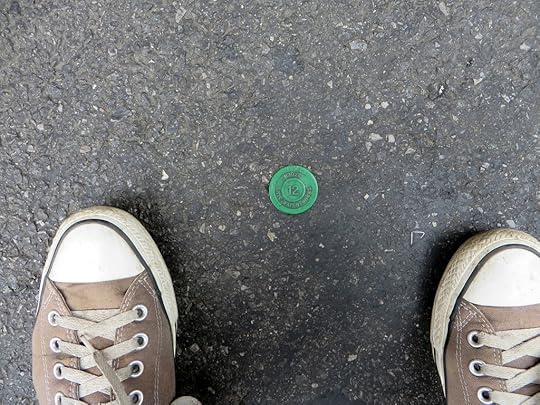
Image © Paul Lukas
When I first moved to New York, I remember seeing these little poker chip things in the street and wondering just what the heck they were. At the time, I thought they were some sort of street art, like Toynbee tiles. It turns out they are pieces of a larger communication system, as Paul Lukas writes in “The Street’s Secret Code”:
These markers are called A-tags (short for asphalt tags). They’re more commonly used in other municipalities as “Call Before You Dig” warning markers, but in New York they’ve been adapted to create a recordkeeping and accountability system. When a utility or contractor is issued a permit to excavate a hole or trench in the roadway — something that happens about 280,000 times a year in New York — the asphalt patch that’s applied at the end of the job must include an embedded A-tag. Each tag has three anchor legs, which, along with a bit of epoxy, help keep the tag in place. The number at the center of the tag indicates the year of the job (“12” for 2012, “14” for 2014, etc.), each broad contracting category has its own color, and each individual contractor or utility is identified either by name or by a unique five-digit number.
So simple and useful. What’s more, they’re an iteration of a previous attempt at the same:
“Before the A-tags, we used painted marks,” says Joseph Yacca, Director of Operations for the New York City Department of Transportation, who helped initiate New York’s A-tag program in 2006. “But the painted marks were just color-coded — they didn’t identify the individual user. For example, every plumber was green, so if you found a green marker, you knew you were looking for a plumber, but you didn’t know who. So we used to have to pull all the old permits and so on. Now we can pinpoint it much faster.”
I love how small ideas like this can organize huge systems such as a city like New York.

October 1, 2014
You’re My Favorite Client
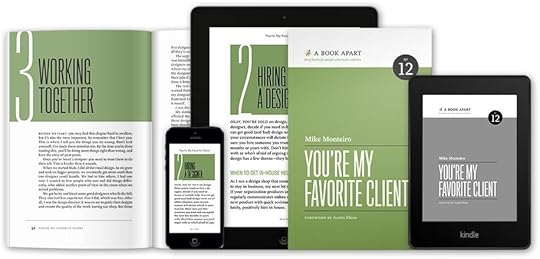
Mike Monteiro drops the other shoe and follows up his amazing book Design Is a Job with something for that special client in your life, You’re My Favorite Client:
Whether you’re a designer or not, you make design decisions every day.
Successful design projects require equal participation from both the client and the design team. Yet, for most people who buy design, the process remains a mystery.
In his follow-up to Design Is a Job, Mike Monteiro demystifies the design process and helps you prepare for your role. Ensure you’re asking the right questions, giving effective feedback, and hiring designers who will challenge you to make your product the best it can be.
It’s a spectacular read, not only for anyone employing the services of a designer, but for us designers too. You can check out an excerpt from Chapter 2 over at A List Apart, and a great interview Khoi Vinh conducted with Mike:
I’ve been doing the primary research for this book for 20 years. I deal with clients every day and I see what works and doesn’t work and I’ve screwed up more times than I’d like to think about. But every lesson in that book is field tested. This book has zero percent theory in it. It was written on a factory floor.
Yes, I know I quoted the same stuff as Kottke did, but I wrote this yesterday and the information is still damn good anyway. Do yourself a favor and pick up a copy of You’re My Favorite Client today!

September 23, 2014
Correspondence with an Ex-Designer
This month I want to share a letter I received from ex-designer, now sheep farmer, Ruth, in reply to my post from a few months back where I wondered what comes next after being a designer. Ruth kindly shared where her life led, and what the other side might look like. I was moved by what she wrote, not only because of her direct experience, but just to hear that I wasn’t alone with my own fears about exhuastion and nourishment.
One letter happily turned into numerous replies back and forth. Ruth graciously gave me permission to share our correspondence, in the hopes that it might also provide comfort and insight others.
Hello Jason, I just completed reading your article “What’s next”.
Just to let you know — there is life, beyond design, though you never quite let it go 100%.
When I went to college to learn design and print, I learned hand setting, then on to Linotype / Monotype machines. My first job, out of college and they were introducing film set typography (Berthold machines) — learning curve again. A number of years later and I was running my own design business and along came… computers and that was an exceptionally steep, self taught learning curve. In order to keep up with the ever changing technology you do have to learn and that takes motivation and desire from an individual point of view.
I enjoyed that “learning” — but what did it for me in the end — “repetitiveness” — my ability to “train” my client became a drain — each client seemed to require, at some point, the same explanations of what was and was not possible with the technology available at the time. It became so draining I called it a day.
I am now a sheep farmer in the northern Highlands of Scotland — and this has also been a challenge of a very different kind — man against nature — but, I have enthusiasm, motivation and a desire to learn something new, something “different”. But — yes, I keep learning about design — web design, which was in its infancy as I was leaving the design field 15 years ago.
What’s next — all depends on you, what motivates you and what makes you happy — there will always be new challenges, but that is what life is all about, isn’t it.
Kind regards
Ruth (now 60 years old — lol)
Ruth’s note warmed me, and after some exchanges, we got onto the topic of exhaustion. I replied back with my personal thoughts on the matter:
Hi Ruth,
The main things I keep coming back to are primarily about exhaustion. I used to think I was working too hard, but even as I found ways to work less, I realized it was something else. I think my exhaustion comes from the industry often taking more from us than it gives, and I’ve only found this to be escalating with how disconnected we’ve become, even in the midst of things like Twitter. Everything feels just a bit thinner than it used to, or at least a bit less nourishing. But when I throw myself in another direction, whether reading, or teaching, or other crafts, I feel nourished again. I’m still working through my own thoughts, and don’t mean to sound so dour about the practice of design, but I think just being aware of what feels good for my mind versus what doesn’t, makes me feel better.
Regards,
Jason
Ruth’s reply was spot on again. Particularly insightful to me, and something I try to continually remind myself of, the expectations of others are their own, and I don’t need to share them:
Hi Jason,
Ah — yes — exhaustion — equates to my being “tired” of the industry — I fully understand where you are coming from.
I found the move to computers a difficult one — I was so familiar / used to working at a drawing board and creating with my own hands — using a mouse and creating on screen was a tough hurdle. Once I overcame that I began to see new possibilities and regained some excitement — however, that was relatively short-lived. As with many things in life — with advantages, came the disadvantages — time scales and demands / expectations of clients. Time scales got shorter — where once, it took 4-5 people a month to put the artwork together for a 1k page book — it became 1 person in a week. I suddenly found I was getting nothing in return — sure, I was paid, but that, somehow, just was not enough. I had the “trappings” — nice home, super sports car and had the ability to fly off to Colorado for long weekends. But it did nothing to fill a gap that had somehow arisen. I took up wood turning — something “creative” I could do with my hands, but even that never quite made up for my working day.
When “new technology” arrives on our doorstep, we do work hard, very hard, to learn it well. I remember being taught to use a ruling pen in college (pre rotrings) and that was so hard to master — my lecturer stated — a designer must master their “tools”. I did that all my working life in design — from hot metal, to film setting to full computerisation — but the “craft” and the mental reward diminished.
I tried “twitter” in it’s early days — but I felt disconnected, did I really want to know if someone was at an airport waiting to fly to XXX — most posts from people seemed utterly irrelevant, so I gave up. Okay, so I am on facebook (reluctantly) — but that is a way of keeping in touch with my brother, sister and their families.
I do believe you are working out, by trying to throw yourself into different things (teaching, reading, writing) — just what is missing. Eventually, something will click into place for you. Just try to remember, no one expects you, as a person, to remain “static” — to always do the same thing, day in, day out — that can lead to stagnation, not just for ideas but for you as a person. I am absolutely NOT advocating that you go do something as dramatic as I did — from designer to sheep farmer (though that was accidental, they were just a way to keep 40 acres of grass down). Also, perhaps try to remember no one has expectations of you — but you have to have some “reward” for your efforts — and I don’t simply mean monetary.
Keep working on it — it is important to you, in your own personal development — that development is important — not the expectations of anyone else. Self-worth is so important.
Ruth
Thank you, Ruth. I greatly appreciate you taking the time to share your experience with me. It has already served as inspiration for whatever comes next.
This piece originally appeared on The Pastry Box Project.

The Benefits of “No”
Liz Danizco on discovering the fringe benefits of saying “no”:
When I say no (e.g., conference talk invites, “pick my brain” invitations, jury solicitations), I immediately add my regret to the No List. I nurture this growing list of no-things, adding category data like dates events would have happened, themes, and date turned down.
Suddenly, I’m making list of cities not seen, airplanes not embarked, and time saved, rather than time taken away. Several months later, I have a made a substantial something. It’s how I’ve marked time.

September 18, 2014
Ed Emberley
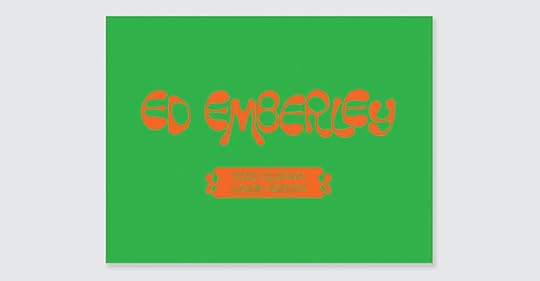
I’m very excited about this upcoming monograph on Ed Emberley from Todd Oldham and Caleb Neelon. I grew up reading and learning from Emberley’s books and his casual approach to systematic drawing. I still marvel at how simple and powerful his books are, and continue to give them as gifts to friends.
These simple and straightforward books, first published in the 1970s, have encouraged a generation of kids to take the drawing process step by step. Contemporary working artists today often cite Ed Emberley as a beloved early inspiration in their development as artists. By encouraging kids to draw using just a few simple shapes, Emberley has made drawing and creating accessible to everyone. As Emberley likes to say, “Not everyone needs to be an artist, but everyone needs to feel good about themselves.”
This definitive monograph on the wide repertoire of Emberley’s life’s work has been beautifully put together by Todd Oldham and Caleb Neelon. Highlighting work spanning more than five decades, this gorgeous and comprehensive book celebrates the talented and prolific life of Ed Emberley.
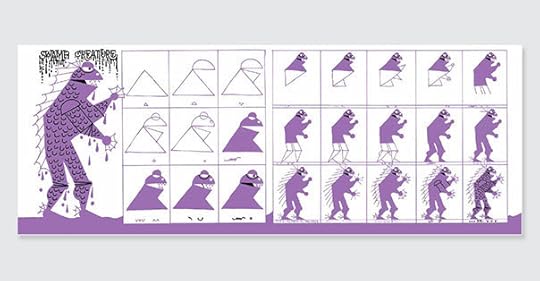

September 16, 2014
Why You Want a Code of Conduct
Erin Kissane expertly outlines why our gatherings need a code of conduct. If you are a member of the web community, or really any community, this is required reading. And if you are a conference organizer, you really shouldn’t be without a strong code of conduct, full stop.
I’m writing this in the late summer of 2014, and the last few weeks have been rough ones where I live. From the tech world’s routine accounts of casual harassment to the grind of violence and systemic unfairness that defines some part of every human society, we are surrounded on all sides by news that is alternately heartbreaking and enraging. And most of the time, in the face of these wrongs, we are helpless. Some of us can vote, some can investigate and expose. That’s often as far as it goes.
But to define a code of conduct is to formally state that your community—your event or organization or project—does not permit intimidation or harassment or any of the other terrible things that we can’t seem to prevent in the rest of the world. It’s to express and nurture healthy community norms. In a small, limited way, it’s to offer sanctuary to the vulnerable: to stake out a space you can touch, put it under your protection, and make it a welcoming home for all who act with respect.
And I think that’s what’s going to win. Enough of us clearly stating that in our spaces, this fuckery will not pass. And continuing to do it—one home, school, workplace, and community at a time—until the ground we cover with a mandate of mutual respect is larger than the gaps in between. Not out of any special benevolence, but because that’s what the world should be.

September 15, 2014
Ode to a Table
A large kitchen in your average New York apartment is like a mythical beast. You may muse about their existence from time to time, but chances run high that they aren’t real things. Many kitchens in one-bedroom apartments here are little more than the wall of a non-kitchen room that happens to have some appliances leaning against it. Your living room is usually reserved first for a couch, and space permitting, a table or closet (closets are a whole other thing).
Having a dining table in New York is a luxury. My first apartment here was big enough to hold a small table which I could sit at comfortably, and another person could join me at uncomfortably. A few years later, I moved to another apartment that was the same size, but differently laid out. This apartment had a huge kitchen with space for many people to occupy simultaneously.
This new kitchen of mine took up nearly a third of the apartment’s footage and was big enough for a proper table. I knew right off I wanted a big farm table — something solid and uncomplicated.
After looking around for a long time trying to find the right balance of form vs price, I became discouraged because big tables are pretty expensive everywhere (who knew?), and settled on one I found on eBay. I say “settled” because I thought “I’ll get this table now, but then buy a really nice one when I can afford it.”
The table was made of unfinished pine from an Amish furniture maker in Pennsylvania and an irregular castoff he was selling at a discount. I couldn’t detect any problematic irregularities from the pictures — these tables should probably have some rough edges anyway—so I bought it.
For the first year I owned the table, I casually regarded it as a thing I planned to replace, so I didn’t put much work into it. It’s a hulk of a thing, with corners that come justthisclose to achieving right angles. I tried sanding its rough legs a few times and was rewarded with some of the biggest splinters I’ve ever encountered in my life. I didn’t take the table makers’ advice to oil the wood, so on cool nights I was sometimes woken by terrifyingly loud pops that I later discovered were the table boards splitting.
I chalked all that up to the table having some character. Later my partner Megan moved in, who sensibly got us to wax and oil the table. Gone were the pale boards and in their place stood a downright healthy looking table, albeit prematurely weathered due to negligence.
We have guests over for a meal most every week, and every week we’d gather around that table. Sometimes the gatherings are jovial events that stretch long into the night. Sometimes they are somber times shared over quiet dinners. Amid broken glasses, spilled drinks, dirt, and countless food items, that stubborn table has stood strong.
I used to think about the table I would get to replace this one. I would often tell people it was a temporary occupant. But now I look at that table and all I can see are the times we’ve spent gathered around it. All the meals and wine, the conversations and laughter, the tears and embraces. This table is full of memories and times spent together. It’s imbued with so much personal history that it’s a part of the family now. I don’t see its surface faults anymore, I just see myself and my loved ones. I wouldn’t trade this table for anything now.
This piece originally appeared on The Pastry Box Project.

Ditching Twitter
Erin Kissane on ditching Twitter:
I called it my rosary, the thing I reached for when I felt anxious, after Metafilter stopped serving that purpose. As Twitter expanded and my own little slice of it grew as well, I called it my front porch and defended its quirks and downsides. But now the magic has turned, in ways that have felt irrevocable. I’m not angry at Twitter for changing, but I’ve been sad to feel that something so oddly entwined with my intellectual and emotional life is now beyond my use.
I’ve felt very much the same lately. Friends being flammed and trolled by the worst people. Colleagues fighting colleagues in a space ill-equipped for even civilized discussion, let alone knee-jerked quipping. I don’t know what to do with Twitter anymore. Like it takes away so much more than it gives. Like the conversations are often more impersonal and inflammatory than they used to be. Like the experience is more toxic than nourishing.
I’ve recently tried just using Twitter less, not engaging as often or as deeply to see if I could somehow keep it around. But not participating feels weird too. I’m thinking I need a combination of less and some of the tactics Erin outlines in her article about curating stronger lists, or even spinning up a quieter public account. One thing is clear, something has to change.

September 10, 2014
NYCTA Graphics Standards Manual Reissue
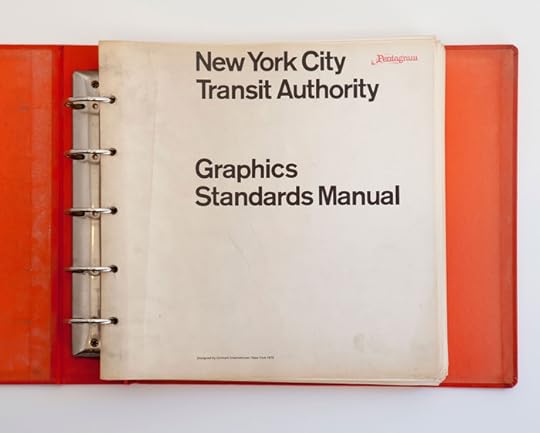
Hot damn! Unimark’s 1970 NYC Transit Authority Graphics Standards Manual is being reissued as a full-size book through an exclusive license from the MTA.
In 1967 the New York City Transit Authority hired Massimo Vignelli and Bob Noorda of the design firm Unimark International to design a signage and wayfinding system that would solve the problem underground.
The work they delivered, the 1970 New York City Transit Authority Graphic Standards Manual, succeeded in that goal and, perhaps unintentionally, the Standards Manual became one of the world’s classic examples of modern design.
This is likely a one-time-only thing, so don’t miss out on some design history!
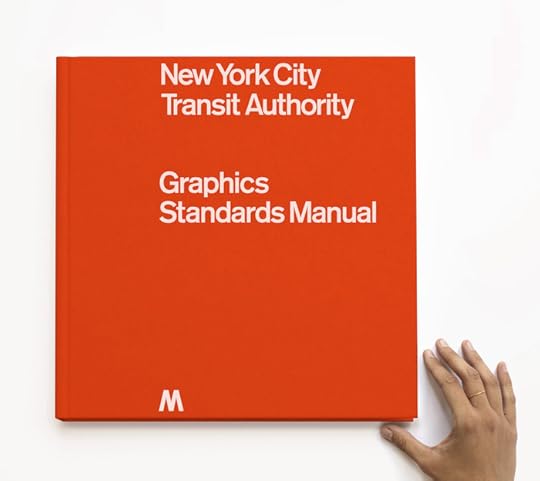

Drafting
I’ve enjoyed contributing here on the Pastry Box this year, if for nothing else than it’s gotten me writing on the regular again. Having a deadline helps drive it into my skull repeatedly that writing has less to do with skill, and more to do with showing up. Making the clackity noise really does work. Just like merely putting pencil to paper counts as sketching. I should know this by heart by now, but I’ve come to the conclusion that I’ll need life-long reminding.
Each month when I feel my Pastry Box deadline approach, I set my mind to sponge-mode in case an idea happens to present itself. I start jotting down notes on paper, in random text files, and peck out sentences in emails to myself while I ride the subway each day. Few of these ever get used for anything, but they all resonated with me in some way when I wrote them.
Over time, I’ve amassed a considerable amount of drafts and unorganized thoughts. Some date back to when I first started blogging (we were really preoccupied with IE6 back then) and the pile since then keeps growing. When I can’t think of anything to write about, I often go back and skim through these drafts to see if there is a loose thread I can pick up. There are many thoughts that were interesting to me for a time, but it rarely happens that one might strike me now. If these thoughts resonated with me before, why can’t they now?
I used to feel like a bit of a failure when I would look back on all these drafts and see them as uncompleted work. Perhaps these ideas are just sketches in their own right. Not exact, not refined, just ideas in their preferred state: ugly. They have a lot of raw gumption, but few have a leg to stand on. Without planning it, my writing process turned out pretty similar my sketching process.
I often think about that maxim of “strong opinions, weakly held”, and it really rings true to me. I love imagining many different scenarios when I sketch or write—and even when I form an opinion—I invariably end up having my mind changed down the road.
The drafts I have aren’t incomplete works anymore, they’re old points of view that have changed. I haven’t picked up some of those threads because I probably don’t agree with them anymore. Making the clackity noise or scribbling in a sketchbook are just ways of trying ideas on for size. If they don’t fit, that’s alright, I can cast them aside. And that’s kind of the point anyway. Good ideas have a way to coming up again, begging to be nurtured and finished.
This piece originally appeared on The Pastry Box Project.

Jason Santa Maria's Blog
- Jason Santa Maria's profile
- 5 followers



